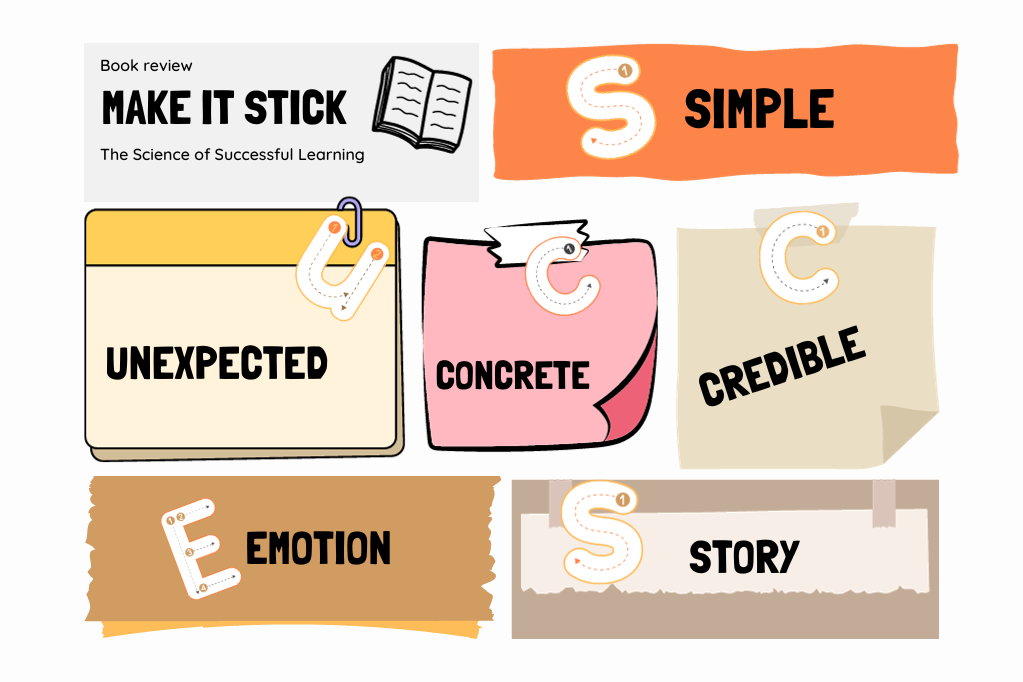Table of Contents
ToggleIn today’s fast-paced world, it’s not enough to have a great idea; it needs to stick. And that’s precisely what Chip Heath and Dan Heath explore in their book, “Make it Stick.” This book review will unpack their SUCCESs formula, an approach to making ideas more memorable and impactful. Whether you’re a coach, consultant, executive, marketer, or sales manager, this book holds universal lessons on how to make your ideas stick and guide the behavior of those around you that will lead to positive change.
S is for Simple:
The first idea in “Make it Stick” is that simplicity is the key. Compact messages help the listener remember and can be achieved by leveraging concepts that are already in place: things that are familiar to the audience (aka schemas). The authors recommend breaking ideas down into the most essential parts and then reinforcing them. This approach helps make the information more memorable and easier to recall. This is the same approach that journalists take in writing their articles by taking the inverted pyramid model: “Don’t bury the lead”. Usually, the headline provides the gist of the article and provides the critical information early on.
U is for Unexpected:
The “curse of knowledge” affects us all when we assume that our audience knows what we know. But The Heath brothers urge us to avoid this and instead use Barry Loewenstein’s “gap theory” to keep our listeners’ interest. This approach presents an open gap between what the audience knows and what they need to know. This piques their curiosity and makes them more interested in the information. In a way, it is about holding your audience’s attention so that they consistently want more. An example of this is when a science teacher presents a question at the beginning of a class, such as, “What makes up the rings of Saturn?” This question keeps the students interested in discovering the answer to the mystery that is unraveled throughout the class.
C is for Concrete:
One of the best ways to make an idea stick is by using vivid and specific examples. The authors cite examples like Jerry Kaplan’s personal computer presentation to Silicon Valley investment capital in 1987. Mr. Kaplan used his maroon leather case, which only contained a blank pad of paper, to illustrate the portability, simple functionality, and a myriad of functionalities (e.g., address book, manage word processing, etc.). His concrete example made it easy for the panel of investors to visualize and understand the features of this innovative product. By using concrete examples, ideas become easily remembered and can act as guiding principles without the need for complicated translation. People respond and remember situations and people more than statistics. It is the same concept that enterprise leaders should adhere to when communicating corporate strategies. When the message is clear and concrete, folks are under the strategy, which drives the right behavior from everyone across the organization.
C is for Credible:
While it’s tempting to rely on authority figures to add credibility to our ideas, the authors suggest that sometimes it’s better to use antiauthority. One example they cite is Pam Laffin’s anti-smoking campaign by the Massachusetts Department of Public Health. In some cases, internal validation can be far more effective. For instance, by using more vivid details, stories, and examples, we can persuade others without relying on stats and figures that may go over the audience’s heads. This concept was clearly depicted in the case of Wendy’s “Where’s the Beef?” campaign to discredit McDonald’s hamburgers or the Sinatra Test used by Safexpress, which guaranteed film producers the safe and timely delivery of Bollywood movies.
E is for Emotion:
This chapter focuses on how tapping into emotions can help make ideas stick. The Heath brothers point out that people will only act when their emotions are engaged. Emotional engagement can be achieved in many ways, and one of the most effective ways is to help people care enough to act. For instance, priming candidate donors to feel and care about the cause before asking for support helps trigger generosity. An example of priming is leveraging Mother Teresa’s principle: If I look at the one, I will act. It is easier to ask potential patrons to give to an actual person than to donate to an entire cause (e.g., Save Africa, Run for the Cure, etc.)
S is for Story:
The final aspect of the SUCCESs model is story. As human beings, we naturally gravitate towards stories; they engage us and make us feel something. Trying to make a point triggers debate. However, sharing our ideas via stories invites our audience to discuss and expand on the topic. It helps make the idea more compelling. One example provided is Stephen Denning’s experience during his stint with the World Bank. Denning employed Zambia’s story on fighting malaria and finding information to combat the disease. Instead of presenting statistics and data, the Zambia story appealed to Denning’s audience and led to the World Bank’s focus on information management.
Conclusion:
“Make it Stick” is an excellent read that explores an effective way of making your ideas more impactful. By using the SUCCESs formula, we learn how to keep things simple, uncommon, concrete, credible, emotional, and engaging. Done correctly, compelling ideas have the power to guide behavior and effectively create change. How are you going to use this formula to elevate your ideas and make a lasting impact?
Don’t forget to check our review of The Art of Decision-Making: Insights from Blink for Product Management.
